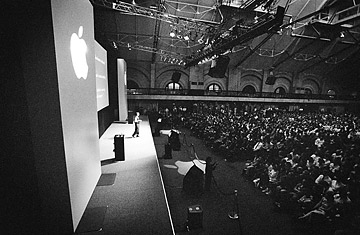
Boston's 1997 MacWorld Expo listens to Jobs on stage.
(4 of 7)
Jobs later called the NeXT-Pixar years "one of the most creative periods of my life" and said his dismissal from Apple had been "awful-tasting medicine, but I guess the patient needed it." It was also the time when he went from high-profile bachelorhood--he had fathered a daughter out of wedlock and dated Joan Baez--to family man. He married Laurene Powell in 1991; by 1998 they were the parents of a son and two daughters.
Meanwhile, without Jobs, Apple was failing on an epic scale. Sculley had given way to a vision-free Apple executive named Michael Spindler, who was replaced by Gil Amelio, who presided over $1.6 billion in losses in Apple's 1996 and 1997 fiscal years. He couldn't even sell the company: deals with potential white knights IBM and Sun Microsystems fell through. The possibility that Apple would run out of cash and cease to exist was not unthinkable. Michael Dell said publicly that Apple should be sold for parts.
Amelio made one smart move during his 17 months at Apple. Just before Christmas 1996, he paid $400 million to buy NeXT, thinking its software could serve as the foundation of a next-generation Mac operating system. He was right: every operating system Apple has created from 2001 on, including the one on the iPhone and iPad, is a direct descendant. NeXT's software came with a bonus: Steve Jobs. With touching naivet, Amelio thought Jobs would cheerfully serve as a figurehead for the company he had co-founded. Instead, six months after the merger, Jobs orchestrated Amelio's ouster and accepted the position of interim CEO--iCEO for short--splitting time with Pixar. "I'm here almost every day," he told TIME in 1997, "but just for the next few months. I'm really clear on it." He finally ditched the i in iCEO in 2000.
Jobs' return cheered up beleaguered Apple fans, but few industry watchers expected miracles. They got them, though. Jobs staged the greatest comeback in the history of business. During his first months back at Apple, Jobs dumped board members, cut staff, slashed costs, killed dozens of products and accepted a $150 million lifeline from perennial bte noire Microsoft. (When Bill Gates made a remote guest appearance during the 1997 Macworld Expo keynote, looming on a video screen over Jobs, the audience booed.)
Jobs rolled out a triumphant contrarian advertising campaign--"Think different"--that gobbled up mind share, if not immediately market share. And he presided over the release of the all-in-one iMac, which came in a translucent candy-colored case crafted by Jonathan Ive, the British industrial designer who would be responsible for every major Apple product to come. "When we took it to the engineers, they said, Oh, and they came up with 38 reasons why it couldn't be done," Jobs told TIME. "And I said, 'No, no, we're doing this.' And they said, 'Well, why?' And I said, 'Because I'm the CEO, and I think it can be done.'" It's a garish period piece now, but at the time it redefined not only what a computer could look like but also how you could feel about it. In 1998 the iMac became the best-selling computer in America.
